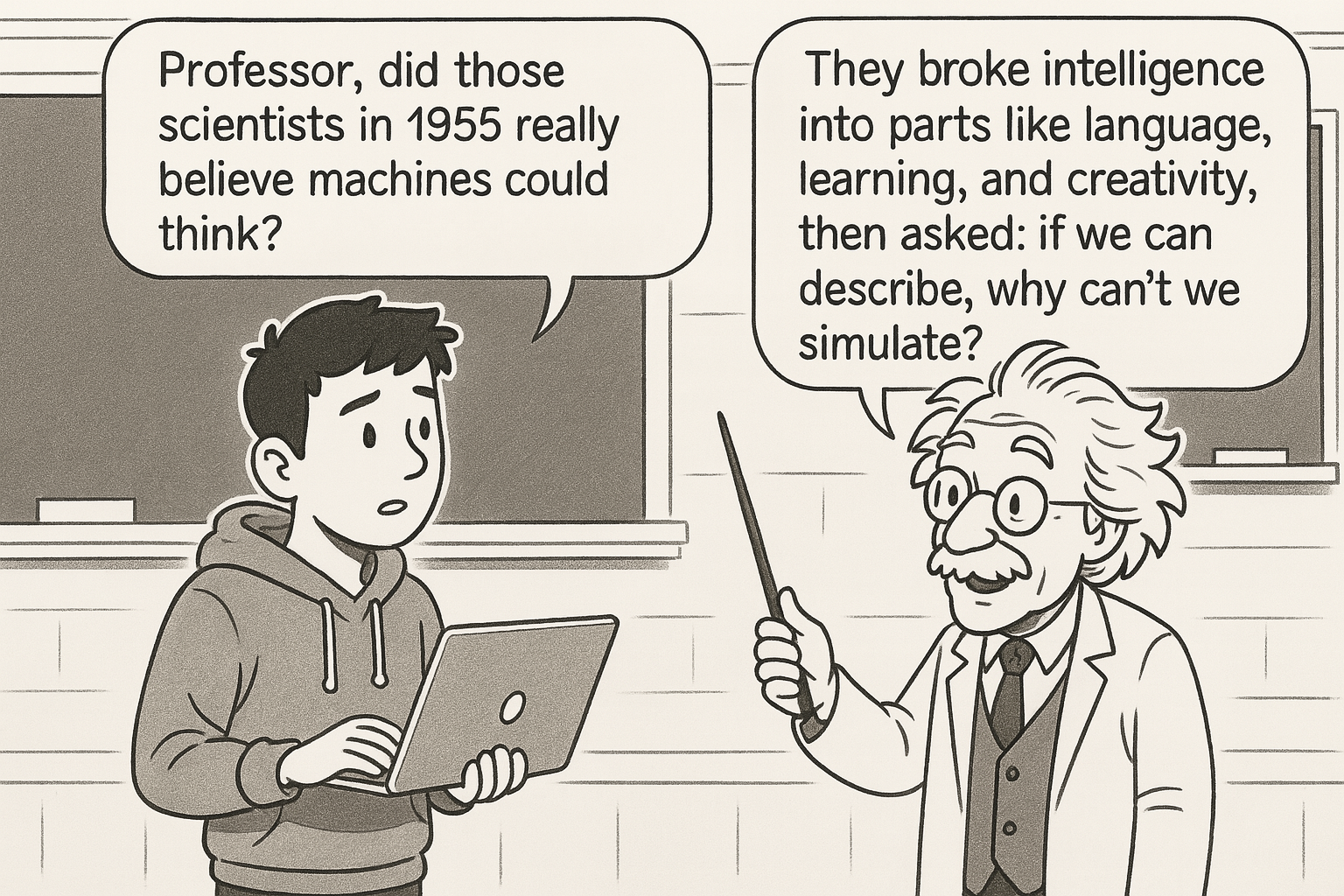Introduction
On August 31, 1955, four visionary scientists submitted a proposal to the Rockefeller Foundation that would change the course of computing forever. John McCarthy from Dartmouth College, Marvin Minsky from Harvard University, Nathaniel Rochester from IBM Corporation, and Claude Shannon from Bell Telephone Laboratories proposed a two-month summer research project on "artificial intelligence" - the first time this term appeared in academic literature. Their 17-page proposal outlined an ambitious plan to gather ten researchers to tackle the fundamental question of whether machines could think.
"Every aspect of learning or intelligence can be so precisely described that machines can simulate it perfectly."
Core Ideas
The proposal rested on a revolutionary conjecture that "every aspect of learning or any other feature of intelligence can in principle be so precisely described that a machine can be made to simulate it." This bold hypothesis challenged the prevailing notion that intelligence was uniquely biological. The four organisers identified seven critical research areas that would form the foundation of AI research for decades to come.
The first area, Automatic Computers, addressed the fundamental challenge of programming limitations rather than hardware constraints. The authors recognised that existing computers had sufficient speed and memory capacity for many intelligent tasks, but programmers lacked the knowledge to write programs that could fully utilise available computational power.
Language processing formed the second research area, proposing that human thought largely consisted of manipulating words according to reasoning and conjecture rules. The authors suggested that forming generalisations involved introducing new words and establishing rules for how sentences containing them would relate to others - an early glimpse into natural language processing.
Neuron Nets represented the third focus area, building on existing work by researchers like McCulloch, Pitts, and others. The proposal questioned how hypothetical neurons could be arranged to form concepts, acknowledging that while partial results existed, the field needed significant theoretical advancement.
The Theory of the Size of a Calculation addressed computational efficiency. Rather than trying all possible solutions to well-defined problems, the authors proposed developing criteria for measuring calculation efficiency and complexity - concepts that would later influence algorithm analysis and computational complexity theory.
Self-improvement emerged as the fifth area, with the authors speculating that truly intelligent machines would engage in activities best described as self-modification. This prescient insight anticipated machine learning and adaptive systems that could enhance their own performance.
Abstractions formed the sixth research domain, focusing on how machines could form abstractions from sensory and other data. The authors recognised that different types of abstraction existed and that developing machine methods for abstraction would be crucial for intelligent behaviour.
The seventh area, Randomness and Creativity, proposed that creative thinking differed from competent thinking through controlled injection of randomness guided by intuition. This concept would later influence Monte Carlo methods and creative AI systems.
Breaking Down the Key Concepts
The Dartmouth proposal essentially argued that intelligence wasn't magical but could be understood as information processing that follows describable rules. Think of it like reverse-engineering a complex system - if you can understand exactly how something works, you can recreate it using different materials or methods.
The authors approached intelligence like software engineers approach any complex problem: break it down into smaller, manageable components. Instead of trying to build a complete thinking machine immediately, they proposed studying specific aspects like language use, learning, and problem-solving separately.
Their conjecture was particularly bold for 1955. At that time, most people viewed intelligence as fundamentally different from mechanical processes. The proposal suggested that the human brain, despite its biological complexity, operated according to principles that could be mathematically described and computationally replicated.
The randomness and creativity aspect was especially innovative. Rather than viewing creativity as completely random or mysteriously inspired, they proposed it involved controlled randomness - like having a sophisticated random number generator that knows when and how to introduce unpredictability into otherwise logical thinking processes.

Results and Significance
The proposal's immediate result was securing $7,500 from the Rockefeller Foundation to fund the 1956 Dartmouth Conference, which brought together mathematicians, engineers, psychologists, and computer scientists for eight weeks of intensive collaboration. This gathering established artificial intelligence as a legitimate academic discipline and created a community of researchers who would drive the field's development.
The Dartmouth proposal represents the intellectual foundation underlying every AI system we interact with. The seven research areas identified in 1955 evolved into today's major AI subfields: natural language processing, neural networks, computational complexity theory, machine learning, computer vision, and creativity in AI systems.
The proposal's emphasis on interdisciplinary collaboration established AI's tradition of drawing from mathematics, psychology, linguistics, philosophy, and engineering. This collaborative approach explains why modern AI development requires diverse skill sets and why the most successful AI companies today employ teams spanning multiple disciplines.
The document's focus on practical programming challenges rather than purely theoretical speculation helped establish AI as an engineering discipline alongside its scientific aspects. The authors recognised that building intelligent systems required not just understanding intelligence but also developing practical methods for implementing that understanding in code.
The proposal's legacy extends beyond specific technical contributions. It demonstrated how ambitious, well-structured research programs could tackle seemingly impossible challenges by breaking them into manageable components and bringing together experts from different fields.
Modern deep learning systems, recommendation algorithms, voice assistants, and autonomous vehicles all trace their conceptual roots back to the research directions outlined in this 17-page document. The proposal's vision of machines that could use language, form abstractions, solve human-level problems, and improve themselves has largely been realised, though the timeline proved much longer than the optimistic pioneers initially expected.
The proposal also established AI's pattern of alternating between periods of high expectations and sobering reality checks. The authors' confidence that "a significant advance can be made in one or more of these problems if a carefully selected group of scientists work on it together for a summer" exemplified the optimism that would characterise AI research, sometimes unrealistically.
Checkout the original proposal here - https://www-formal.stanford.edu/jmc/history/dartmouth/dartmouth.html